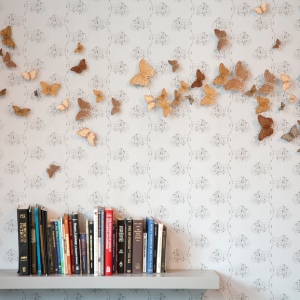Material wallpapers for many owners are wounded. But from the usual material, they do not differ anywhere, with the exception of an increased width, which significantly reduces the number of seams in the room, and at the same time, the effort and time is almost 2 times. Today we will talk about the advantages of wide wallpaper, how to make the wall right and how to get a room.
Our compatriots are accustomed to working with standard wallpaper canvases whose width is 53 centimeters. But foreign markets are able to buy increased 70 and 100-centimeter rolls. The main advantages of using meter wallpaper:- Reducing the number of joints between individual wallpaper canvases, which makes it possible to talk about the so-called "seamless" effect that favorably affects the interior.
- The facilitated cloth mounting procedure, which is associated with a smaller number of pieces that are required for pasting facilities.
- The price of a meter roll is below the cost of two rolls of standard 53-centimeter wallpaper, which allows you to significantly save when finishing a large room.


- First you need to wash the walls of the primer. Also suitable wallpaper glue, which should be bred before a more liquid state. As such an impregnation, you can take the cheapest product, however, such treatment is needed to increase the clutch of wallpaper with the surface of the walls and improve the properties of the adhesive composition. Before work, be sure to make sure in the drying of the primer.
- When using foam borders, they should be installed on the wall before flowing surface with wallpaper.
- Measure the height of the floor from the floor to the curb / ceiling, add to the resulting result of 5-10 centimeters, which is necessary as a stock. Divide the length of the roll of meter wallpaper on this magnitude to find out the number of bands that will work out from this roll. Read more about calculation here. When cutting the cloth, consider that you may need to combine the pattern on the material.
- Return from the alarm of the wall of the distance of 1 meter, here you need to spend a vertical line with a plumb and a long line.
- Apply an adhesive composition to the surface, which should be prepared in advance.
- Pick the first canvas in height, and can be glued to the base, focusing on the intended line. In this case, it is necessary to turn the second side of the panel side. At the top is also subject to the canvas, it will be covered subsequently.
- Further, it should be smoothed out the wallpaper to drive out the air, with a wallpaper roller or spatula.
- When you finish do this procedure, it is necessary to arm a knife and a wide metal spatula, which will serve as a kind of guide when cutting off the excess wallpaper.
- Raw Wallpaper may not turn out, in this case, wait until they dry, and cut it then.
- If it was found that the wallpaper in some places were not completely glued, correct this moment.
- If you leveled the walls well, then stick the next door can be glued without much difficulty.
- When fixing the second, it is necessary to customize it to the previous one height, smoothing the wallpaper and at the same time kicking the air.
- You can not stretch the wallpaper to achieve a clear junction - first everything will work out, but it will disappear as soon as the cloth dries.
- Fliseline wallpapers are lighted easier, as this material can be moved after you have shone it for 10 minutes.
- Do not use the glue that contains in its composition additives for fast drying, as only experimental finishes can work with these substances.
If there is no smooth dock, you can make a small intersection if you use one-photo wallpaper. The backstage should reach two or three centimeters. Then make through a knife through the cut in the place where two canvases intersect to cut through them at the same time. It remains only to get trimming and straighten the canvas, pre-slipping the joint with glue.

- When sticker bands in the corner should make a nest on the adjacent wall, which will be 2-3 cm. If you are exposed to more material, do more superfluous to the required size using a sharp knife.
- For pasting with wallpaper, under the batteries, cut the material into small parts. At the same time, it is important to monitor the matching of the pattern, do not be discouraged if you will not work from the first time. The same applies to the space above the window or door. It is best to cut pieces of wallpapers for these sections from one panel meter wallpaper.
- It is easy to bold the ceiling with wide wallpaper, because you will have to fix a smaller number of sheets if we compare the material with standard rolls.

Material wallpapers can be combined, as well as ordinary to diversify the decoration finish, hide the deficiencies of the planning - to reduce the height of the ceiling, expand narrow passages, as well as to emphasize the favorable sides of the room or focus on the main object of the furniture.


































